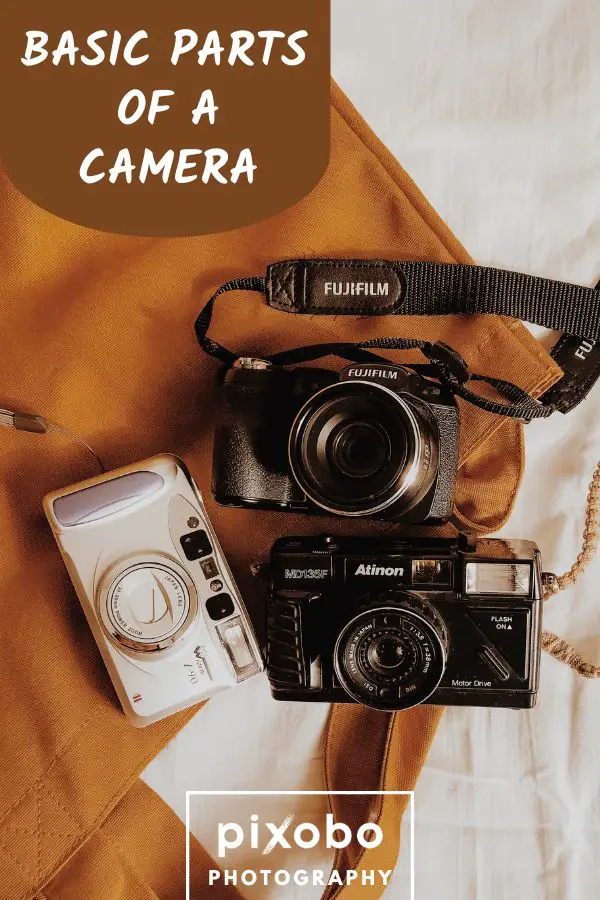Photography is a very interesting hobby and can be a lucrative career. But it is not just about buying a camera and taking photos.
You see, taking wonderful photos is more about understanding how a camera works and learning the function of its parts. Otherwise, you will not make it to the next level, and you will not enjoy photography.
Cameras are complicated machines, but it does not necessarily mean that you need some technical expertise. It only needs patience, hard work, and dedication.
To help you out, this comprehensive guide will teach all the details about camera parts and how to use them properly. You will also learn the different types of cameras and accessories.
What Are the Different Types of Cameras in Photography?
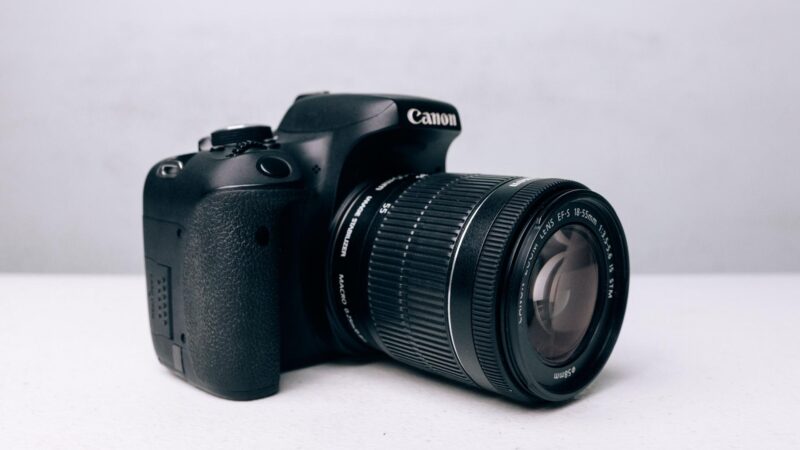
Before learning the basic parts of a camera and its functions, it would be helpful if you first understand how it works and what happens once you take a photo. In general, all cameras work on almost the same principle. But then, each type of camera works differently than the others. Here are the main types of cameras and how they work:
1. SLR Cameras
In photography, SLR stands for single-lens reflex, and SLR cameras use films that are sensitive to light. As the name implies, SLR cameras use a single lens, and light passes through the lens to enter the camera. Light is reflected by a movable mirror, which explains the term “reflex.” It also creates an image of the film, which will be developed.
2. DSLR Cameras
The “D” in DSLR cameras stands for ‘digital.” Instead of images stored in films, they are stored digitally via memory cards. This means that you can already view the photos without printing them. DSLR cameras are smaller and lighter than SLR cameras, and photos can be edited. But like SLR cameras, DSLRs work using movable mirrors.
3. Point-and-Shoot Cameras
Point-and-shoot cameras can either be analog or digital. This type of camera doesn’t have a mirror and no viewfinder. The image that you see on the screen is not the same image that passes through the lens. Point-and-shoot cameras are much simpler to use and are ideal for casual users, but their lenses are fixed and are not interchangeable.
4. Mirrorless Cameras
Mirrorless cameras are a special kind of digital camera since they don’t use reflex mirrors, hence the name. Here, the light passes through the lens and is fed directly to the sensor. They also use an electronic viewfinder (EVF) instead of an optical and are smaller and lighter than DSLRs. Mirrorless cameras are also slowly replacing DSLRs.
5. Smartphone Cameras
Cameras on smartphones can be considered digital since images are stored digitally. But although smartphone cameras are handy, their sensors are small compared to DSLRs and mirrorless cameras, and their resolutions are much lower. Despite having advanced features, SLRs, DSLRs, and mirrorless cameras produce higher-quality images.
Parts of a Camera and Their Functions
Now that you have an idea about the different types of cameras and how they work, you can easily understand their parts. As explained above, not all cameras have a mirror, which means that it is not considered a common part of a camera. So, without further ado, here are the parts of a camera and their functions, along with some accessories:
1. Camera Body
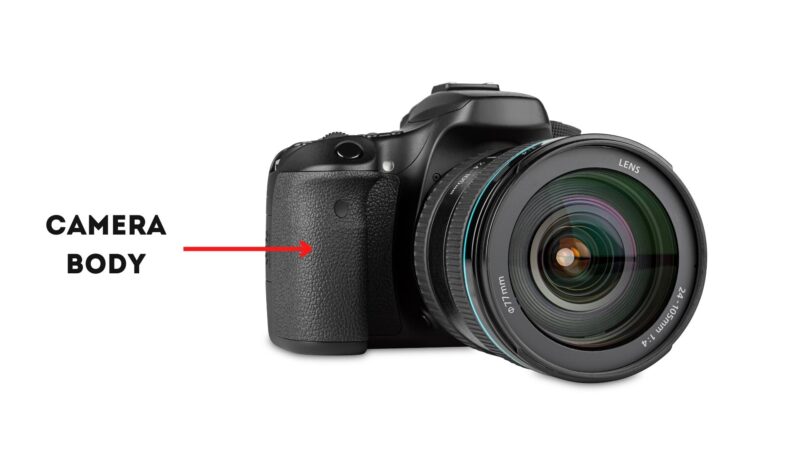
Like any gadget, all cameras have a body. It houses all the external parts of a camera. Camera bodies come in different sizes and materials. Film cameras have bigger bodies than DLSRs, while mirrorless cameras are smaller than DSLRs. Point-and-shoot cameras have the smallest bodies, so they are sometimes called compact cameras.
Older cameras are usually made of die-cast metal alloy, while the newer ones are mostly made of polycarbonate compound with fiberglass. Most new camera models are so-called weather-sealed and are designed to be more protected against various elements such as dust, humidity, and moisture. Some cameras are also waterproof.
2. Image Sensor
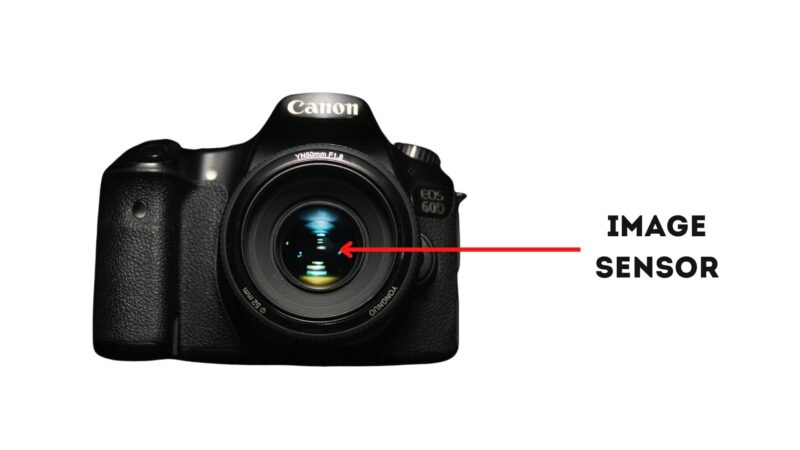
The image sensor is considered the heart of a camera and is the most important factor to be considered before buying a camera. Camera sensors are the ones responsible for receiving light photons that are converted to electric signals, resulting in pixels (picture elements) to create an image. SLR cameras don’t have sensors since they use film.
Image sensors are in megapixels (MP), wherein 1 MP has 1 million pixels. The most common type of sensor is the CMOS (Complementary Metal–Oxide Semiconductor). Sensor sizes include medium format, full-frame, APS-C (Advanced Photo System type-C), and micro four-thirds. The larger the sensor, the higher the quality of an image.
3. Image Processor
The image processor of a camera is responsible for processing images, hence the name. Also called the ISP (image signal processor), this programmable electronic chip takes information from the sensor and uses them to create an image. Considered the brain of the camera, it also does autofocus, detects eyes and faces, and other functions.
Image processors are located inside the camera and are specifically designed for certain camera models and brands. Sony cameras use BIONZ image processors as their trademark, while Canon cameras use DIGIC (Digital Imaging Integrated Circuit) image processors. On the other hand, Nikon cameras use EXPEED image processors.
4. Shutter
The shutter release button is what you press if you are about to take a picture. It can be mechanical or a combination of mechanical and electrical. Once you press the shutter button, you are sending a signal to open the shutter, which is inside your camera. This will then allow light to reach the image sensor, which will eventually create the image.
The length of time from the opening to the closing of the shutter is called the shutter speed, which is a very crucial factor when taking a photo. Shutter speeds are measured in terms of a fraction of a second. Hence, 1/4 is a quarter of the second (0.25 sec), and 1/250 is 4 milliseconds. Note that faster shutter speeds mean shorter exposure to light.
5. Lens
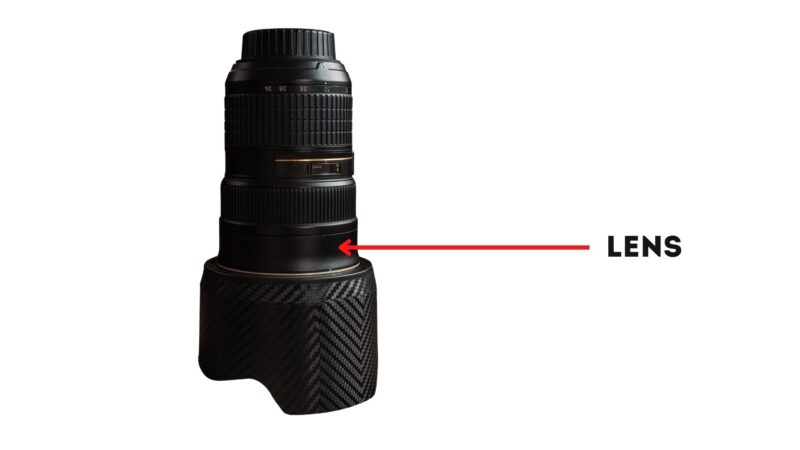
Most camera lenses today are interchangeable, although most camera brands have their lenses. They allow light to enter the camera and direct it to the sensor. This barrel-shaped lens is filled with a series of glass elements and is usually made of optical glass. Meanwhile, smartphone camera lenses are mostly made of thin plastic.
There are many different types of camera lenses, which include wide-angle, telephoto, standard, macro (for close-up), tilt-shift, zoom, and prime (with fixed focal length). Each lens type has its focal length range and is designed for a particular type or type of photography. Some lenses have additional features, such as a built-in autofocus motor.
6. Aperture
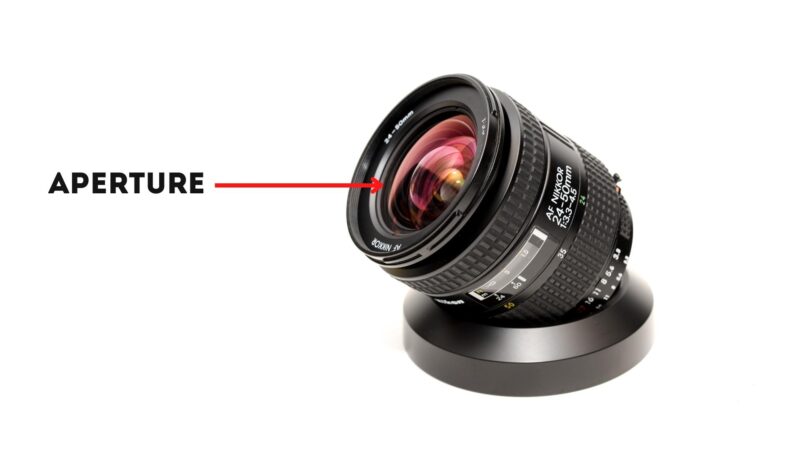
The aperture is the adjustable opening of a camera lens and where the light passes through to enter the camera. Expressed in F-stops, the size of the aperture opening not only controls the brightness (amount of light) of your image, but also indicates how much of your subject will be in focus or out of focus or depth-of-field (DOF).
Having a large aperture (usually f/11.4 – f/F2.8) will result in a shallow DOF. In short, there will be a large amount of both foreground and background blur, which is typically used in portraits. On the other hand, a smaller aperture (usually f/11 .4 to f/22) will result in having a large DOF. Moderate aperture settings are typically from f/4.0 to f/8.0.
7. Viewfinder
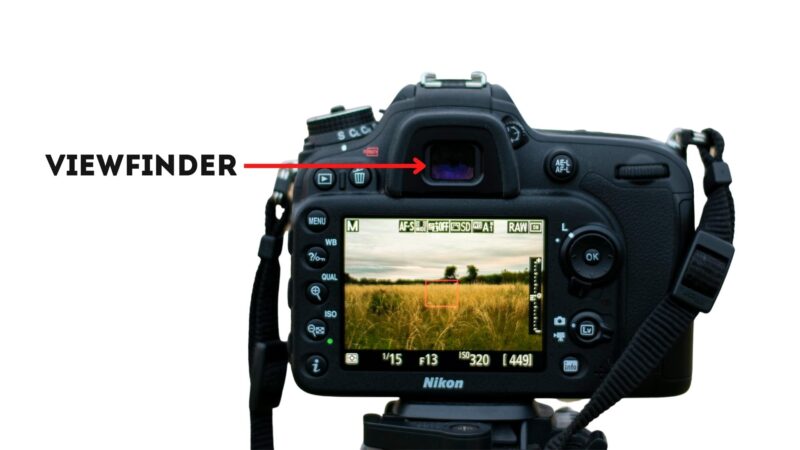
As the name suggests, the viewfinder is a part of a camera that allows you to see your subject. It is the tiny rectangular window at the back of your camera that serves as a telescope. Here, you can frame your photo, and you will have an idea of what your photo will look like. A camera viewfinder also allows you to focus even on the smallest details.
In twin-lens reflex (TLR) cameras, viewfinders are miniature Galilean telescopes that are placed in the camera body. Today, there are two main types of camera viewfinders – optical viewfinder (OVF) and electronic viewfinder (EVF). DSLR cameras use OVF, while mirrorless cameras use EVF, wherein images are displayed on LCD monitors.
8. Display Screen
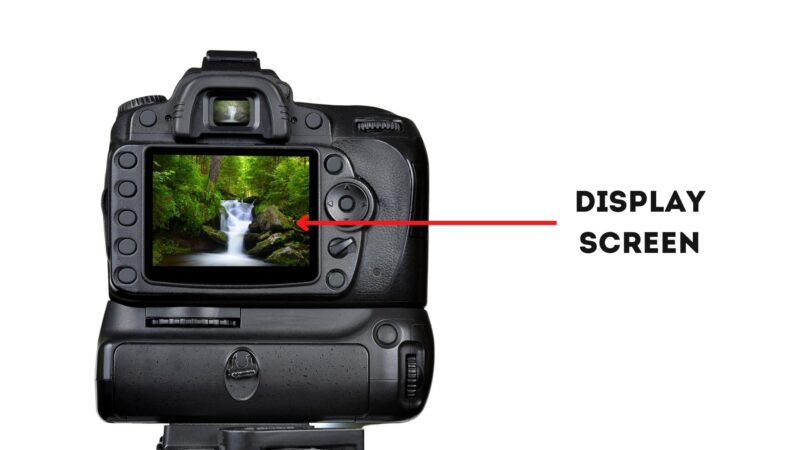
Older film cameras have no LCD (Liquid Crystal Display) screen, while newer versions have. Meanwhile, all DSLRs and mirrorless cameras have a full-color LCD screen located at the back. Most DSLR cameras have an LCD screen and a viewfinder, while most mirrorless cameras use an LCD or OLED (organic light-emitting diode) screen.
Some high-end cameras have dual screens, wherein the second one is located on the top side of the camera. Most camera models have fixed LCD screens, but some of them use flip-out screen. These days, most mirrorless cameras no longer have a viewfinder since you can now set Live View on LCD screens, along with some adjustment settings.
9. Flash
As the name implies, a camera flash emits light, but only for a very short time. Also sometimes called a strobe, the flash adds light to a scene when shooting photos. It is mostly used when taking photos in dim light areas or at night to compensate for the lack of brightness. But then, incorrect use of flash can have a negative effect on your images.
Outdoor photography rarely requires the use of a flash. Indoor portrait photography may not also need a flash unless the room has a low light or you want to create shadows. Most cameras have a built-in flash, but many professional photographers prefer using an external flash instead. Flash speed or duration is the time from full-power flash to off.
10. User Controls
Different cameras have a different number of user controls, which are located in different areas, depending on the model. They allow you to adjust the different settings you need and manipulate the actions of your camera. These controls can be in the form of knobs, buttons, and dials. Some high-end cameras have menus on their LCD screens, though.
User controls can either be manual or automatic. Nonetheless, the most important ones are the power button, shutter release button, aperture button, and ISO settings. Other controls include an autofocus button, white balance, flash button, Live View switch, choosing between portrait and landscape, sports and night mode, and many more.
11. Battery
Like other electronic gadgets, all modern cameras are useless without batteries. During the era of film cameras, most universal batteries were disposable and had a short life. This means that you have to buy new ones once they die. Fortunately, alkaline batteries today are rechargeable. However, only point-and-shoot cameras use them these days.
As time passed by, camera batteries became proprietary. For instance, batteries for Nikon cameras cannot be used in Canon cameras or other models. Most DSLR and mirrorless cameras use rechargeable lithium-ion batteries (Li-ion), which have higher power capacity compared to the other types. Smartphones also use this battery type.
12. Hot Shoe
In photography, a hot shoe is a slot or a metal bracket located at the top side of your camera where you can mount external accessories to the camera. The term “hot” means it has electrical pins. Although a hot shoe is commonly used in external flash, some designs can be used in external microphones, wireless triggers, and viewfinders.
A hot shoe should not be confused with a cold shoe, which is also a slot that connects external accessories to the camera. However, the latter does not transmit electrical signals to the camera. Unfortunately, hot shoe mounts are not universal. It means that camera manufacturers have their hot shoe, and you cannot use it for other brands.
13. Flange
The flange is the part of your camera where you connect your lens to the camera body. Therefore, it is only present in cameras with interchangeable lenses. Once you mount it properly, the locking mechanism and contact pins will align your lens to the body of the camera. Afterward, you may now control your camera lens according to your needs.
The flange focal distance (FFD) is the distance between the sensor and the lens mount (flange). FFD is usually measured in millimeters. Different camera manufacturers and camera types have different flange focal distances. Nikon Z-mount lenses have an FFD of 46.5 mm, Canon EF mount lenses are 44 mm, and Sony E-mount is only 18 mm.
14. Memory Cards
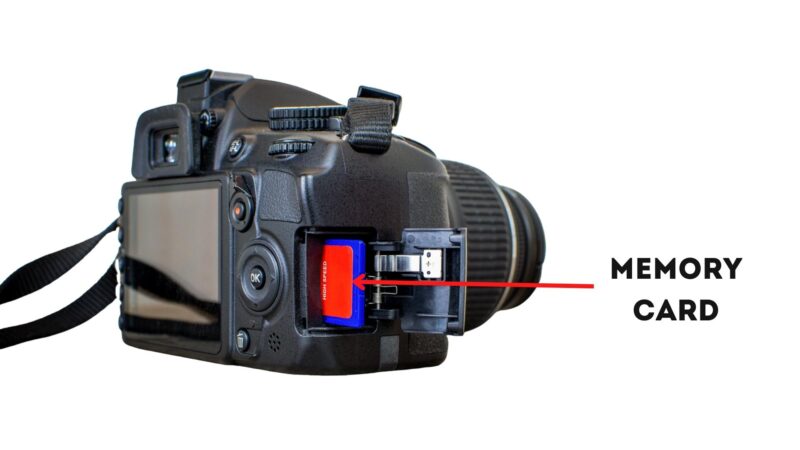
DSLR and mirrorless cameras are sold with memory cards. But most of the time, the storage capacity is not enough. This is why you should have an additional memory card. All memory cards have the same purpose – to store photos and videos so you can easily transfer them to another device. However, not all memory cards are the same.
The most common type of memory card is the SD (Secure Digital) card. Standard SD cards can store up to 2GB, while SDHC (Secure Digital High Capacity) cards have a range of 4-32GB. SDXC (Secure Digital Extended Capacity) cards can store 64GB-2TB. Smaller cameras and smartphones use a smaller version called microSD cards.
Essential Camera Accessories
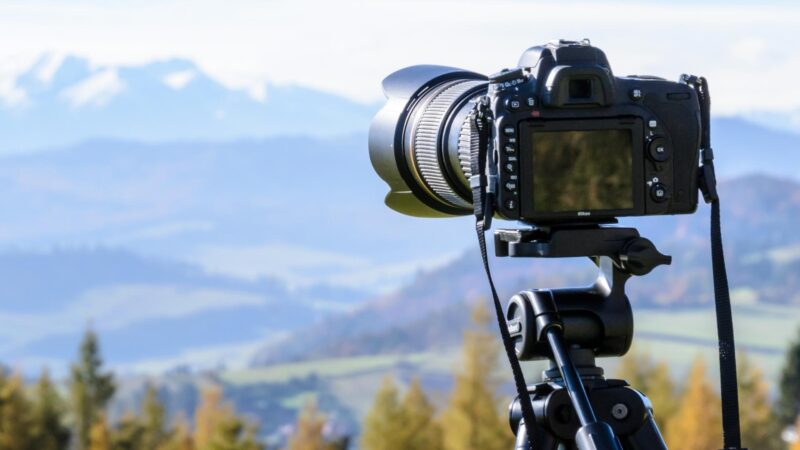
- Lens Hood – Blocks or reduces the amount of lens flare and glare in your photos. It also adds contrast and protects your lens from fingerprints, scratches, and debris.
- Tripod – Aside from keeping the camera steady while you are taking photos, it also acts as a “third hand” so you can make adjustments freely.
- Remote shutter release – Allows you to join a group photo without holding your camera. Most of them have a timer, so you can delay the shooting.
- Memory card reader – It reads and copies data from SD cards and transfers them to your laptop or computer; great alternative in case you have no internet access.
- Camera straps – Straps can be for the neck, waist, or shoulders. They help you protect your camera from an accidental drop.
- Camera bag – Bags don’t only help you carry your camera comfortably, but they also avoid your camera from drawing attention while you are traveling.
With so many camera parts to learn, you might feel pressured to study them. The key here is to start with the basic parts and their uses. Try experimenting with them, and little by little, you will eventually learn the other parts. If you are a beginner in photography, don’t buy expensive cameras with extra features that you don’t need yet.
